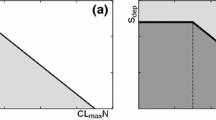Abstract
The critical loads of acidity and nitrogen has been mapped for Swedish forest soils, using data from the Swedish Forest Inventory. The Swedish critical load map used in negotiations has been based on a number of ecological receptors. For terrestrial ecosystems criteria based on no adverse effect on growth, soil stability and groundwater quality was used. For surface waters, stream and lake biology was used as indicators for setting limits to acidification. A reduction of 75% of the acidity deposition in relation to 1988 is required in order to protect 95% of the forest resource in Sweden from effects of soil acidification. A reduction of 50% of the nitrogen deposition is required to avoid exceedance in more than 5% of the area. The mapping work was carried out by using the PROFILE model.
Similar content being viewed by others
References
Hettelingh, J., Downing, R. and de Smet, P.: 1991,Mapping Critical Loads for Europe, Coordination Center for Effects, RIVM. CCE Technical Report No. 1, RIVM Report No. 259101001.
Sverdrup, H. U., de Vries, W. and Henriksen, A.: 1990,Mapping critical loads, Nordic Council of Ministers, Copenhage. Miljörapport 1990:15, Nord 1990:98.
Sverdrup, H. and Warfvinge, P.: 1993a, Calculating field weathering rates using a mechanistic geochemical model-PROFILE,Journal of Applied Geochemistry 8, 273–283.
Sverdrup, H. and Warfvinge, P.: 1993b, Soil acidification effect on growth of trees, grasses and herbs, expressed by the (Ca+Mg+K)/Al ratio,Reports in Environmental Engineering and Ecology 1:93, 1–184. Chemical Engineering II, Box 124, Lund University. 221 00 Lund, Sweden.
Sverdrup, H. and Warfvinge, P.: 1995a, Critical loads of acidity for Swedish forest ecosystems, in Staaf, H. and Tyler, G. (eds.),Effects of acid deposition and tropospheric ozon on forest ecosystems in Sweden, Ecological Bulletins 44, 75–89.
Sverdrup, H. and Warfvinge, P.: 1995b, Past and future changes in soil acidity and implications for growth under different deposition scenarios, in Staaf, H. and Tyler, G. (eds.),Effects of acid deposition and tropospheric ozon on forest ecosystems in Sweden, Ecological Bulletins 44, 335–362.
Warfvinge, P. and Sverdrup, H.: 1992, Calculating critical loads of acid deposition with PROFILE — a steady-state soil chemistry model,Water, Air and Soil Pollution 63, 119–143.
Author information
Authors and Affiliations
Rights and permissions
About this article
Cite this article
Harald, S., Warfvinge, P. & RosÉn, K. Critical loads of acidity and nitrogen, based on multiple criteria for different swedish ecosystems. Water Air Soil Pollut 85, 2375–2380 (1995). https://doi.org/10.1007/BF01186189
Issue Date:
DOI: https://doi.org/10.1007/BF01186189




